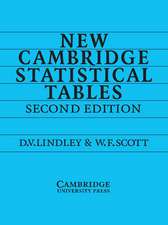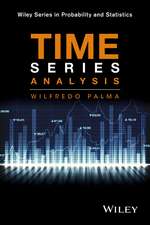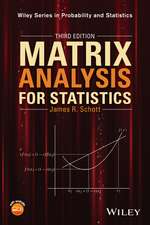The Surprising Mathematics of Longest Increasing Subsequences: Institute of Mathematical Statistics Textbooks, cartea 4
Autor Dan Romiken Limba Engleză Paperback – feb 2015
| Toate formatele și edițiile | Preț | Express |
|---|---|---|
| Paperback (1) | 352.50 lei 6-8 săpt. | |
| Cambridge University Press – feb 2015 | 352.50 lei 6-8 săpt. | |
| Hardback (1) | 642.68 lei 6-8 săpt. | |
| Cambridge University Press – feb 2015 | 642.68 lei 6-8 săpt. |
Preț: 352.50 lei
Nou
Puncte Express: 529
Preț estimativ în valută:
67.47€ • 73.31$ • 56.71£
67.47€ • 73.31$ • 56.71£
Carte tipărită la comandă
Livrare economică 21 aprilie-05 mai
Preluare comenzi: 021 569.72.76
Specificații
ISBN-13: 9781107428829
ISBN-10: 1107428823
Pagini: 363
Ilustrații: 3 b/w illus. 94 exercises
Dimensiuni: 152 x 227 x 20 mm
Greutate: 0.5 kg
Editura: Cambridge University Press
Colecția Cambridge University Press
Seria Institute of Mathematical Statistics Textbooks
Locul publicării:New York, United States
ISBN-10: 1107428823
Pagini: 363
Ilustrații: 3 b/w illus. 94 exercises
Dimensiuni: 152 x 227 x 20 mm
Greutate: 0.5 kg
Editura: Cambridge University Press
Colecția Cambridge University Press
Seria Institute of Mathematical Statistics Textbooks
Locul publicării:New York, United States
Cuprins
1. Longest increasing subsequences in random permutations; 2. The Baik–Deift–Johansson theorem; 3. Erdős–Szekeres permutations and square Young tableaux; 4. The corner growth process: limit shapes; 5. The corner growth process: distributional results; Appendix: Kingman's subadditive ergodic theorem.
Recenzii
'The story of longest monotone subsequences in permutations has been, for six decades, one of the most beautiful in mathematics, ranging from the very pure to the applied and featuring many terrific mathematicians, starting with Erdős–Szekeres's 'happy end theorem' and continuing through the Tracy–Widom distribution and the breakthrough of Baik–Deift–Johansson. With its connections to many areas of mathematics, to the Riemann hypothesis, and to high-energy physics we cannot foresee where the story is heading. Dan Romik tells the tale thus far - and teaches its rich multifaceted mathematics, a blend of probability, combinatorics, analysis, and algebra - in a wonderful way.' Gil Kalai, Hebrew University of Jerusalem
'How long is the longest increasing subsequence in a random permutation? This innocent-looking combinatorial problem has surprisingly rich connections to diverse mathematical areas: Poisson processes and Last-passage percolation, growth processes and random matrices, Young diagrams and special functions … Its solution weaves together some highlights of nineteenth- and twentieth-century mathematics, yet continues to have growing impact in the twenty-first. Dan Romik's excellent book makes these exciting developments available to a much wider mathematical audience than ever before. The minimal prerequisites ensure that the reader will also encounter mathematical tools that have stood the test of time and can be applied to many other concrete problems. This is a wonderful story of the unity of mathematics, and Romik's enthusiasm for it shines through.' Yuval Peres, Principal Researcher, Microsoft
'This is a marvelously readable book that coaches the reader toward an honest understanding of some of the deepest results of modern analytic combinatorics. It is written in a friendly but rigorous way, complete with exercises and historical sidebars. The central result is the famous Baik-Deift-Johansson theorem that determines the asymptotic distribution of the length of the longest increasing subsequence of a random permutation, but many delicious topics are covered along the way. Anyone who is interested in modern analytic combinatorics will want to study this book. The time invested will be well rewarded - both by enjoyment and by the acquisition of a powerful collection of analytical tools.' Michael Steele, University of Pennsylvania
'Mathematics books that concentrate on a problem, rather than on a technique or a subfield, are relatively rare but can be a wonderfully exciting way to dive into research. Here we have the felicitous combination of an extraordinarily fascinating and fruitful problem and a literate tour guide with a terrific eye for the best proof. More like a detective story than a text, this elegant volume shows how a single wise question can open whole new worlds.' Peter Winkler, Dartmouth College
'Timely, authoritative, and unique in its coverage …' D. V. Feldman, Choice
'How long is the longest increasing subsequence in a random permutation? This innocent-looking combinatorial problem has surprisingly rich connections to diverse mathematical areas: Poisson processes and Last-passage percolation, growth processes and random matrices, Young diagrams and special functions … Its solution weaves together some highlights of nineteenth- and twentieth-century mathematics, yet continues to have growing impact in the twenty-first. Dan Romik's excellent book makes these exciting developments available to a much wider mathematical audience than ever before. The minimal prerequisites ensure that the reader will also encounter mathematical tools that have stood the test of time and can be applied to many other concrete problems. This is a wonderful story of the unity of mathematics, and Romik's enthusiasm for it shines through.' Yuval Peres, Principal Researcher, Microsoft
'This is a marvelously readable book that coaches the reader toward an honest understanding of some of the deepest results of modern analytic combinatorics. It is written in a friendly but rigorous way, complete with exercises and historical sidebars. The central result is the famous Baik-Deift-Johansson theorem that determines the asymptotic distribution of the length of the longest increasing subsequence of a random permutation, but many delicious topics are covered along the way. Anyone who is interested in modern analytic combinatorics will want to study this book. The time invested will be well rewarded - both by enjoyment and by the acquisition of a powerful collection of analytical tools.' Michael Steele, University of Pennsylvania
'Mathematics books that concentrate on a problem, rather than on a technique or a subfield, are relatively rare but can be a wonderfully exciting way to dive into research. Here we have the felicitous combination of an extraordinarily fascinating and fruitful problem and a literate tour guide with a terrific eye for the best proof. More like a detective story than a text, this elegant volume shows how a single wise question can open whole new worlds.' Peter Winkler, Dartmouth College
'Timely, authoritative, and unique in its coverage …' D. V. Feldman, Choice
Descriere
This book presents for the first time to a general readership recent groundbreaking developments in probability and combinatorics related to the longest increasing subsequence problem.

























